This Mojo Marinade infuses your favorite proteins with zippy garlic citrus Caribbean notes made with simple fresh ingredients and is SO easy – just sit back and let the tantalizing marinade do all the work!
This Mojo Marinade is the must-make marinade of the summer and all year long. It’s intensely flavorful singing of garlic, citrus, cilantro, jalapeño, oregano, cumin, and pepper. The intoxicating blend is bright, fresh, zesty, tangy, herby, garlicky, peppery and breathes life into chicken, pork, salmon, and shrimp. You can also use the mojo marinade as a sauce on top of grilled or roasted vegetables, eggs, potatoes, etc. Best of all, this mojo marinade requires hardly any chopping and takes all but 5 minutes to whisk together. Now, just add your protein and let the marinade do all the heavy lifting. It couldn’t be any easier or more delicious!
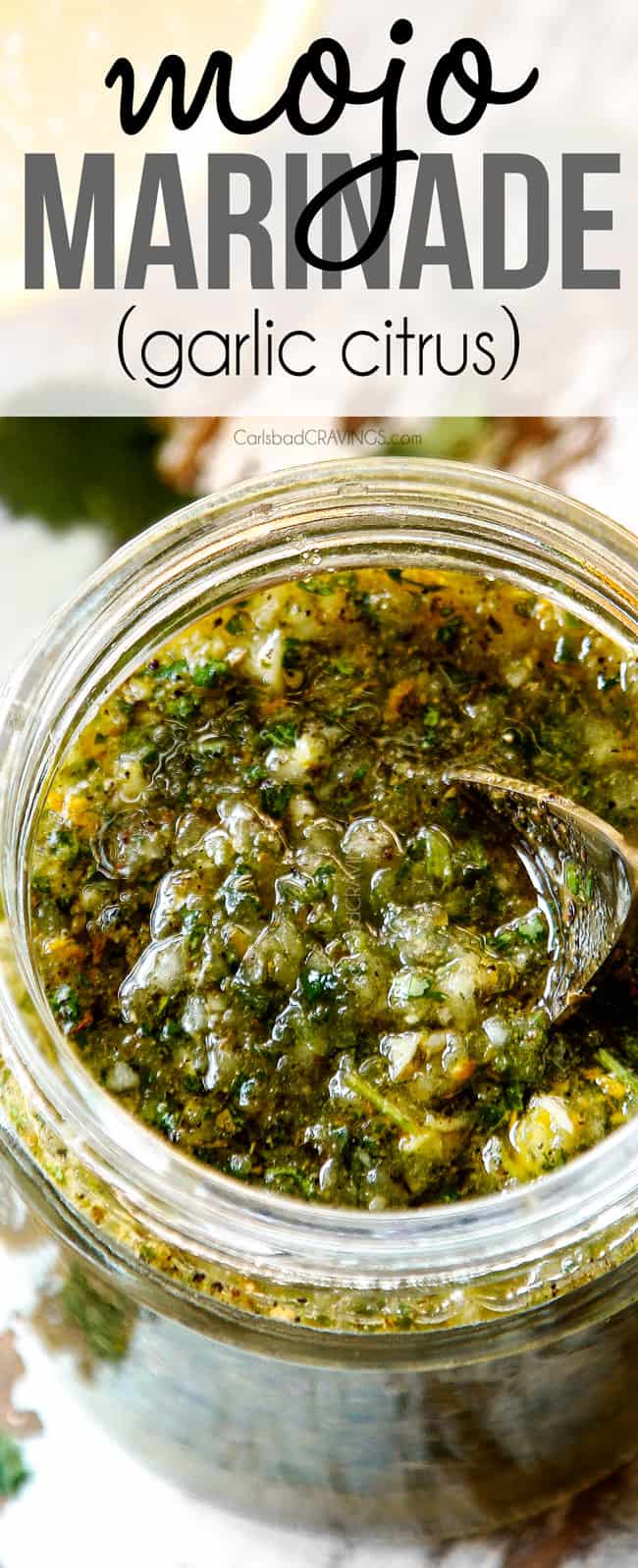
PIN THIS RECIPE TO SAVE FOR LATER
Mojo Marinade Recipe
This mojo marinade is a breathe of fresh air with its fresh herbs and bright, tangy, garlicky, sour notes. I love how the clean citrus backdrop allows the garlic and herbs to truly shine and the pepper and jalapeno add a kick of heat without overwhelming the marinde. This mojo marinade is also gluten-free, keto-friendly, healthy and super versatile.
You can make this mojo marinade as spicy as you want by adding more or less jalapenos and pepper, as garlicky as you want by adding more or less garlic, as herby as you want by adding more or less cilantro and/or oregano or as sour as you want by adding more or less lime/lemon juice. For us, however, it’s perfect just the way it is.
To arrive at this perfection, I experimented with different ingredients such as omitting the cilantro and jalapeno (which aren’t always included) and different proportions of ingredients. I found the marinade requires a generous quantity of oomph (garlic, pepper, oregano, cumin) and that adding cilantro and jalapeno elevate it to sublime. Cuban mojo marinades don’t typically include cilantro and jalapenos but other Caribbean mojo marinades do, so this recipe is the best of both worlds.
This mojo marinade makes dinner time a breeze and is one of the best and easiest marinades you’ll ever make. It can also be doubled or tripled and frozen for later so you always have the marinating tool to tenderize and add tons of flavor to chicken, pork or seafood at your fingertips. Let’s mojo!
What is mojo?
Mojo is a Spanish word meaning “sauce” that originated in the Canary Islands. Its influence expanded to Cuba, Puerto Rico, Dominican Republic and all throughout the Caribbean due to heavy Canarian emigration. As such, mojo has expanded to describe different sauces of different regions consisting of olive oil, local chilies, garlic, cumin and cilantro. Each country has slight variations using different acids such as vinegar, lemon juice or orange juice or different seasonings.
Cuban mojo is possibly the most popular in the United States. It describes any sauce made with olive oil or pork lard, garlic, oregano and bitter orange juice. It is commonly used to flavor yuca and to marinate pork and whole chicken.
How is Mojo pronounced?
Mojo is a Spanish word so the j makes an “h” sound like in jalapeno. So, instead of pronouncing mojo “mo-joe,” it is pronounced”mo-ho.”
What is Mojo Sauce Made Of?
There are many variations of mojo sauce between countries and even from neighbor to neighbor. Some marinades include cilantro, some don’t, some marinades include jalapeno, some don’t, some include oregano, some don’t (those without oregano are called mojito). This mojo marinade recipe combines the most flavorful elements to create the most dynamic marinade. Of course, you can omit or add ingredients to your liking:
- Bitter orange juice or 2 parts orange juice to 1-part lime and lemon juice
- Cilantro
- Garlic
- Jalapeno
- Pepper
- Oregano
- Cumin
- Olive Oil
A few variables:
Cuban mojo marinade is characterized by the bitter Seville orange that is native to Southeast Asia but is now found in abundance in Cuba. It is such a way of life in Cuba that many Cubans have their own Seville orange trees. The sour flavor of the Seville orange is crucial to the mojo marinade but is not widely available throughout the US.
Fortunately, there is an easy substitute: 2 parts orange juice to 1-part lime juice and lemon juice. Add the zest of the orange and now you have all the orange flavor with just the right amount of sour.
I’ve added optional jalapeno and cilantro to this mojo marinade and I suggest you do the same. The cilantro adds a vibrant zesty, herby freshness and the jalapeno adds a much-needed kick without making the marinade spicy (unless you go with two jalapenos).
Oil is another variable. Many traditional mojo marinades do not include oil because it is going to be used on roasting a pig, which has plenty of fat. When the marinade is used on other proteins, it should contain some oil, but the amount of oil can vary depending on the protein. Fattier meats, such as pork and beef, require less oil; leaner proteins such as chicken and fish, require more oil to help prevent them from drying out.
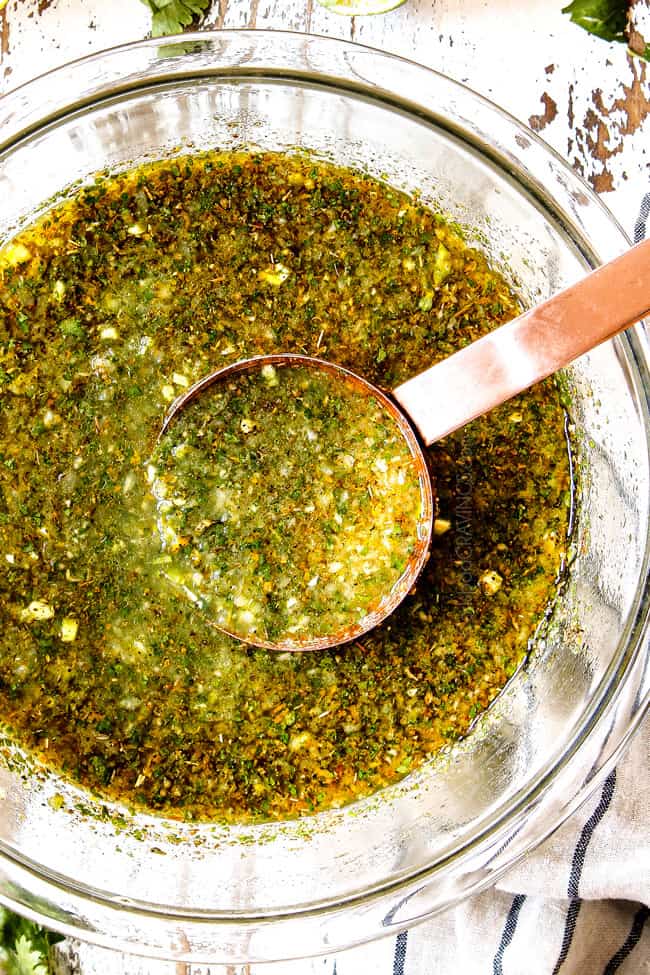
What does mojo marinade taste like?
Mojo marinade tastes bright, fresh and tangy, zesty, citrusy, garlicky, peppery and slightly sour. You should be able to taste the garlic, pepper and slightly sour notes as they harmoniously blend with the aromatics.
Is Mojo seasoning spicy?
Mojo seasonings can vary but most consist of oregano, cumin, garlic, black pepper, and optional jalapeno. Mojo should be slightly peppery with a bite from the onions and garlic and the option of how spicy is left up to you whether you want to add jalapeno or not.
This mojo marinade is not spicy but just flavorful. It has a little kick from garlic, pepper and jalapeno, but should still be mild enough for everyone. You can make your marinating protein spicier and more flavorful by brushing on some of the reserved marinade or using the reserved mojo sauce as a dip.
Mojo Marinade Ingredients
This mojo marinade uses pantry friendly ingredients. Here’s what you’ll need:
- Orange juice: you will need 2 oranges to make ½ cup orange juice. Use freshly squeezed because we also need the zest of one orange.
- Lemon and lime Juice: freshly squeezed is best but you can use bottled juice if it is pure fleshly squeezed without any additives.
- Olive oil: use quality extra virgin olive oil for the best flavor.
- Onion: ½ yellow onion will do the trick. Don’t substitute with a sweet onion.
- Cilantro: adds a zesty, citrusy punch. If you don’t like cilantro, just skip it.
- Garlic: adds the signature garlicky flavor. You can use more or less depending on how pronounced you would like the garlic.
- Jalapeño: remove the seeds and membrane before roughly chopping because they contain most of the heat.
- Ground cumin: adds a smokey, earthy undertone that rounds out the flavor profile and punches up the other flavors.
- Dried oregano: is a classic addition to mojo marinade. It’s aromatic, earthy, and minty.
- Salt: is crucial! It enhances all of the flavors, especially the garlic. If you don’t have enough salt, the marinade will taste very bland. If that’s the case, make sure to salt your protein.
How to Make Mojo Marinade
- Finely chop fresh ingredients in food processor. Mojo marinade is traditionally made by blending garlic, coarse salt, peppercorns, etc. with a mortar and pestle. This mojo marinade recipe, however, utilizes the modern-day food processor so all you have to do is roughly chop (barely) the onion and jalapeno before adding to the food processor. Combine with cilantro and peeled garlic and pulse until finely chopped.
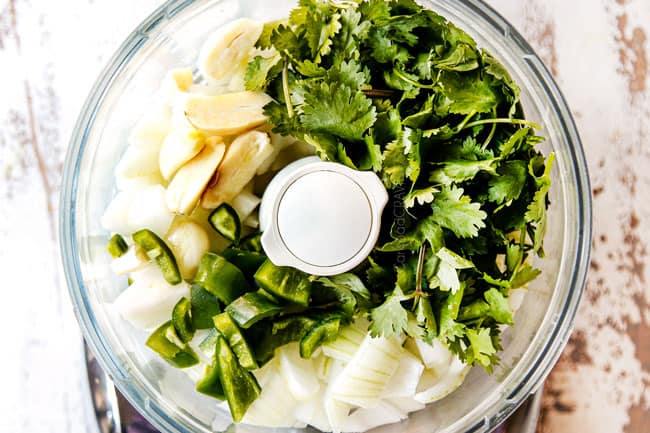

- Combine all of the ingredients in a bowl. Next, transfer the chopped fresh ingredients to a large bowl. Add the orange juice, orange zest, lime juice, lemon juice, ground cumin, dried oregano and olive oil, and give everything a stir. You don’t want to add the liquid ingredients to the food processor or it will leak out the bottom.
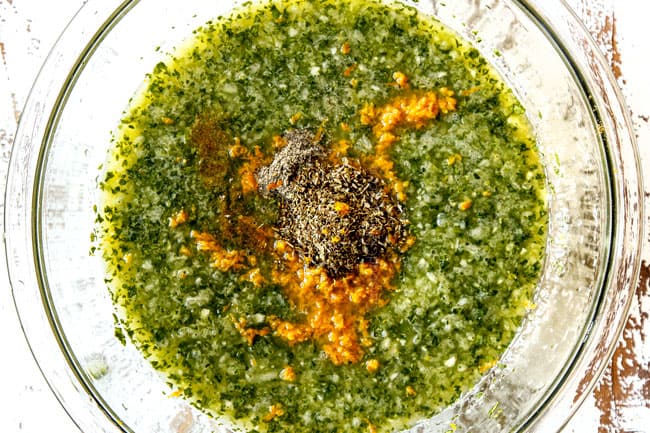
- Reserve marinade. Remove about ¼ cup to brush on your cooked protein or to dip it in.
- Marinate. Add protein to the mojo marinade and marinate in the refrigerator.
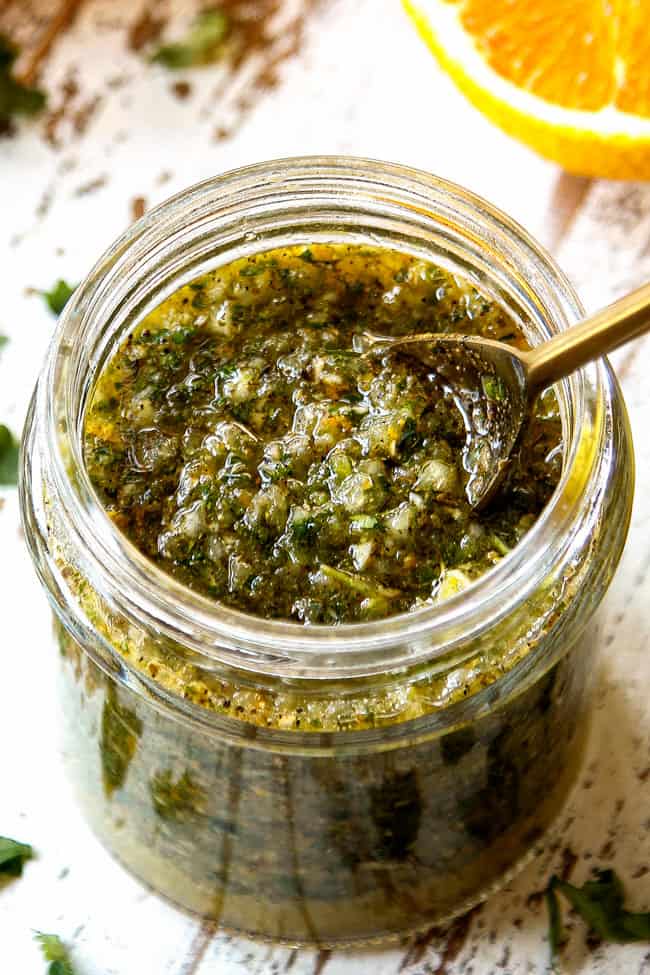
HOW LONG TO MARINATE with mojo marinade?
This mojo marinade contains a high ratio citrus so you don’t want to over-marinate your protein because the citrus can break down the protein and make it mushy. Large, tougher cuts such as pork shoulder and pork butt can be marinated up to 24 hours but steak, and chicken thighs should be marinated just up to 12 hours. Only marinate salmon and shrimp for up to 30 minutes.
How does this Mojo Marinade work on your meats?
This mojo marinade tenderizes and flavors your protein so all you have to do is marinate and cook! In order for a marinade to be effective, it must contain acid, fat, salt and flavor enhancers. The combination of these elements ensures that the protein is juicy, succulent and flavorful from the inside out. Here’s how it works:
- FAT: the olive oil dissolves fat-soluble flavor compounds from the seasonings and aromatics and evenly disperses them throughout the protein. Fat also adds moisture to the protein so it’s especially important on lean cuts such as chicken breasts and pork tenderloin. If you are using the marinade just as mojo sauce, then you can skip the oil.
- ACID: the orange juice, lime juice and lemon juice help tenderize the meat by breaking down lean muscle fibers. The citrus trio also boast layers fresh, bright, tangy flavor.
- SALT: creates a brine, which increases the moisture capacity of the protein, helping it become juicer and more flavorful. First, the salt hydrates the muscle tissues via osmosis; second, it changes the cells’ structure so that they can no longer contract when cooking. This means less water will be squeezed out and lost, resulting in juicier protein. Finally, the brine draws the aromatic flavor further down below the surface into the protein and enhances all of the flavors. You can pile on herbs and seasonings but if a marinade is missing salt – it will taste bland.
- FLAVOR ENHANCERS: ingredients in mojo marinade can vary, but this recipe boasts citrus, garlic, onion, cilantro, jalapeno and pepper.
TIPS FOR MOJO MARINADE
- Scale recipe. The mojo marinade makes enough to marinate 2-3 pounds of protein. You can half the recipe if making 1-2 pounds of protein or scale up for a larger protein. Alternatively, you can use unused leftover marinade on vegetables, eggs, etc.
- Adjust to taste. The mojo marinade should be garlicky, peppery and slightly sour. Remember the marinade will taste 1000X stronger than your finished protein because it is concentrated. You can adjust to taste by adding more or less of any of the ingredients. You can make it spicier by adding additional jalapenos or reserving the jalapeno seeds and adding them to taste.
- Reserve marinade. Reserve 1/4-⅓ cup marinade to bush all over your finished protein. You will be amazed at how much this amps up the flavor of the protein.
- Freeze protein in marinade. If you can’t get to cooking your marinated protein within 12 hours, then you can freeze the protein in the marinade to use later. That’s a benefit of using the freezer bags – you can just toss them right into the freezer for later!
- Freeze only once. If you plan on freezing the protein in the mojo marinade, then use fresh protein. You should not freeze protein twice.
- Don’t over-marinate. Due to high amount of citrus, don’t marinate chicken or steak longer than 12 hours. If you use chicken tenderloins or fillets, however, you will only want to marinate 2 hours because the citrus can cause the chicken to become mushy. Larger cuts or tougher cuts can be marinated for up to 24 hours.
- Bring meat to room temperature before cooking. You always want to let any protein sit at room temperature for 15-30 minutes before cooking (and larger cuts even longer). The logic is that room temperature chicken will cook faster if started at a higher temperature which means the outside is less likely to overcook and less time for moisture to be released while cooking. It also cooks more evenly and you aren’t left with an overcooked exterior and cold interior.
- Use a meat thermometer to check for doneness. Always use a meat thermometer so you don’t undercook OR overcook your protein. Steak should be cooked to 145 degrees F (for medium), pork to 145 degrees F, fish to 145 degrees F and chicken to 165 degrees F.
- Let protein rest. After your protein is finished cooking, transfer it to a cutting board and let rest 5-10 minutes before chopping or slicing so it has time to reabsorb the juices that have pushed towards the outside of the protein. If you cut into the protein immediately after cooking, valuable, moisture-giving juices will run out.
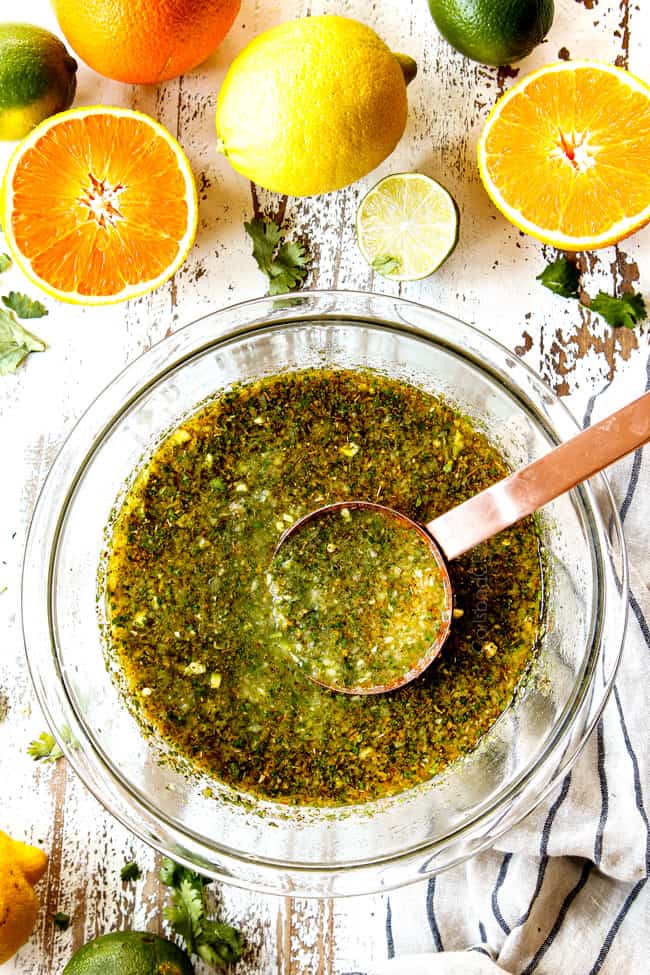
MARINADE FOOD SAFETY TIPS
When it comes to marinating any protein, there are some safety rules to follow to avoid cross contamination. Follow these simple rules to maintain sanitary conditions and food safety:
- Use food safe containers. I prefer food-safe sealable plastic bags such as freezer Ziploc bags. They really allow the marinade to envelop the protein vs. a dish in which the marinade might not cover all of the protein. Sealable bags are also great for easy cleanup – just toss them! You may also use food grade plastic, stainless steel, or glass containers and cover with plastic wrap if they don’t have a lid.
- Squeeze out excess air. When using a plastic bag, make sure to squeeze out excess air before sealing then roll up the bag so the protein is nice and snug.
- Flip protein occasionally. If you marinate the protein in a shallow dish, make sure to flip the protein over occasionally so it marinates evenly.
- Marinate in the refrigerator. Always marinate protein for a prolonged period of time covered in the refrigerator and not at room temperature to avoid food-born illness. Only remove it from the fridge to the counter 60 minutes before you’re ready to cook to help bring it to room temperature so it cooks evenly.
- Don’t reuse marinade. Never reuse a marinade even for basting unless you boil it first to destroy any harmful bacteria. If you want to use the marinade for basting, drizzling or dipping, it is best to reserve a portion before you add the protein. I highly recommend reserving at least ¼ cup mojo marinade for this purpose.
- PRO TIP: You can also reserve a couple tablespoons of mojo marinade (not contaminated) to drizzle on veggies before grilling or cooking like I do in my chicken fajita recipe and many kabob recipes to make them uber flavorful without any extra work!
MOJO RECIPE VARIATIONS
This mojo marinade is completely customizable. Here are a few options:
- Omit the jalapenos or add more jalapenos
- Add red pepper flakes instead of jalapenos
- Omit the cilantro or add more or less
- Add parsley instead of cilantro or in addition to
- Add more or less garlic
- Make it more sour by adding more lemon juice and less orange juice or less sour by adding less lemon juice
- Mix up the flavor profile by adding other seasonings/flavorings such as paprika, chipotle chile powder or liquid smoke
How to store mojo marinade
Transfer mojo marinade to an airtight container such as a sealable bag or jar with a tight-fitting lid. Refrigerate for up to one week in the refrigerator. Transfer to the freezer if marinating any longer.

HOW TO FREEZE MOJO MARINADE
This mojo marinade is awesome to freeze! I love doubling the batch and freezing half to use later. You can also freeze half of a single batch if you plan on marinating only a small portion of protein. Here’s how to freeze:
- Freeze mojo marinade. Transfer mojo marinade to an airtight container and freeze for up to three months. Defrost in the refrigerator.
- Freeze protein in marinade. Add the protein to the marinade and freeze. Freeze for up to 3 months. When you’re ready to use, the protein will marinate as you defrost in the refrigerator.
WHAT CAN I MARINATE WITH MOJO MARINADE?
The better question is what can’t you marinate with this mojo marinade! This mojo marinade is fabulous on everything. It is particularly popular on roasted pork shoulder but is also wonderful on all cuts of pork, chicken, steak, shrimp and salmon. I last used it on flank steak tacos with pineapple mango salsa and it was sensational (recipe coming soon)!
Once you pick your protein, pick your cooking method – grill (my fav for chicken and steak), bake (great for larger cuts such as pork shoulder), cook in a skillet, slow cook or pressure cook.
Next, make sure to cook your protein to the correct temperature:
- Chicken: cook to 165 degrees F
- Pork: cook to 145 degrees F
- Steak: cook to 145 degrees F
- Fish: cook to 145 degrees
- Shrimp: cook just until opaque
How Do You Use Mojo Sauce?
This mojo marinade is also delicious served as mojo sauce! It will add tons of flavor to everything it touches. Mojo sauce is especially handy if you want to make the whole marinade recipe but only need to marinate 1-2 pounds of a protein. You can use the leftover marinade as sauce on:
- Veggies: roasted root vegetables Roasted Broccoli, Roasted Broccolini, Roasted Cauliflower, Roasted Carrots, roasted asparagus Saluted Brussels, roasted butternut squash, Spouts, Glazed Carrots
- Potatoes: Company Mashed Potatoes, Slow Cooker Mashed Potatoes, Smashed Potatoes, Twice Baked Potatoes, Roasted Pesto Potatoes
- Protein: grilled chicken, pork, salmon, steak
- Breakfast: scrambled eggs, omelettes, frittata, savory crepes
- Mexican favorites: tacos, tostadas, nachos, quesadillas, enchiladas
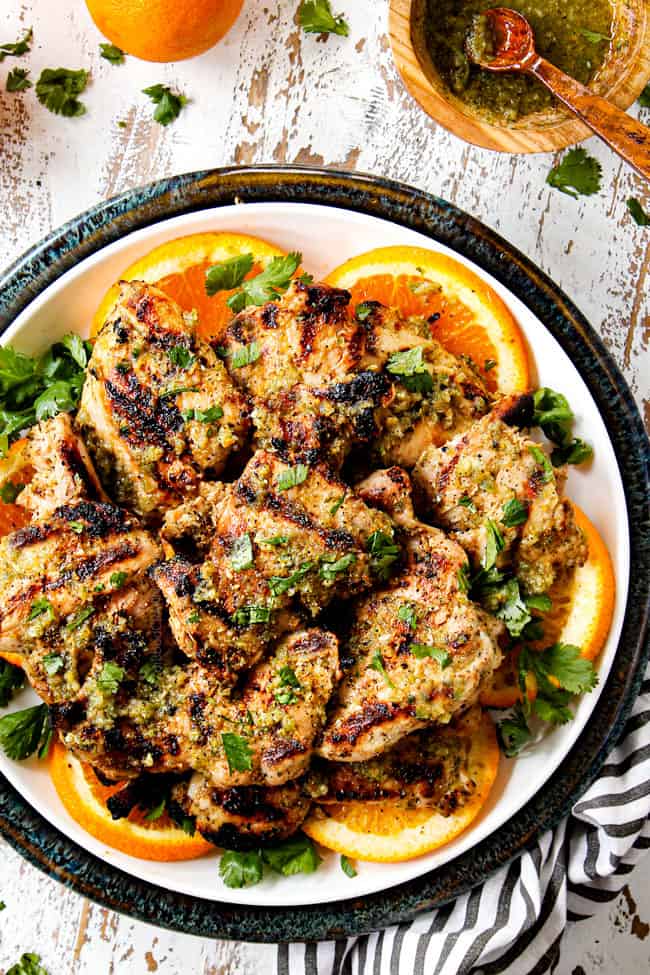
Want to try this Mojo Marinade RECIPE?
Pin it to your Dinner or Marinade Board to SAVE for later!
Find me on Pinterest for more great recipes! I am always pinning :)!
©Carlsbad Cravings by CarlsbadCravings.com
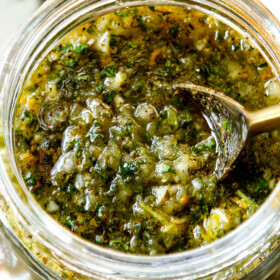
Mojo Marinade
Save This Recipe To Your Recipe Box
You can now create an account on our site and save your favorite recipes all in one place!
Ingredients
- 6 cloves garlic peeled
- 1/2 yellow onion roughly chopped
- 1/2 cup loosely packed cilantro
- 1-2 jalapenos deveined, seeded
- 2 tablespoons fresh oregano or 2 teaspoons dried oregano
- 2 teaspoons ground cumin
- 1 1/4 teaspoon salt
- 1 teaspoon pepper
- 1/2 cup fresh orange juice
- 1 tablespoon orange zest
- 1/4 cup lemon juice
- 1/4 cup lime juice
- 1/3 cup extra virgin olive oil
Instructions
- Add the garlic, onion, cilantro, jalapenos and fresh oregano (if using) to your food processor and pulse until very finely chopped, scraping the sides down as needed. Transfer to a large bowl and stir in all remaining ingredients.
- Reserve ¼ cup marinade to brush on protein after cooking or to serve as a dip.
- This marinade makes enough to marinate 2-3 pounds of chicken, pork, fish, shrimp or beef.
Notes
Tips and Tricks
- Scale recipe. The mojo marinade makes enough to marinate 2-3 pounds of protein. You can half the recipe if making 1-2 pounds of protein or scale up for a larger protein. Alternatively, you can use unused leftover marinade on vegetables, eggs, etc.
- Adjust to taste. The mojo marinade should be garlicky, peppery and slightly sour. Remember the marinade will taste 1000X stronger than your finished protein because it is concentrated. You can adjust to taste by adding more or less of any of the ingredients. You can make it spicier by adding additional jalapenos or reserving the jalapeno seeds and adding them to taste.
- Don’t over-marinate. Due to high amount of citrus, don’t marinate chicken or steak longer than 12 hours. If you use chicken tenderloins or fillets, however, you will only want to marinate 2 hours because the citrus can cause the chicken to become mushy. Larger cuts or tougher cuts can be marinated for up to 24 hours.
- Bring meat to room temperature before cooking. You always want to let any protein sit at room temperature for 15-30 minutes before cooking (and larger cuts even longer). The logic is that room temperature chicken will cook faster if started at a higher temperature which means the outside is less likely to overcook and less time for moisture to be released while cooking. It also cooks more evenly and you aren’t left with an overcooked exterior and cold interior.
- Use a meat thermometer to check for doneness. Always use a meat thermometer so you don’t undercook OR overcook your protein. Steak should be cooked to 145 degrees F (for medium), pork to 145 degrees F, fish to 145 degrees F and chicken to 165 degrees F.
- Let protein rest. After your protein is finished cooking, transfer it to a cutting board and let rest 5-10 minutes before chopping or slicing so it has time to reabsorb the juices that have pushed towards the outside of the protein. If you cut into the protein immediately after cooking, valuable, moisture-giving juices will run out.
storage
Transfer mojo marinade to an airtight container. Refrigerate for up to one week in the refrigerator. Transfer to the freezer if marinating any longer.HOW TO FREEZE
You can double the recipe or freeze half of a single batch if you plan on marinating only a small portion of protein. Here’s how to freeze:- Freeze mojo marinade. Transfer mojo marinade to an airtight container and freeze for up to three months. Defrost in the refrigerator.
- Freeze protein in marinade. Add the protein to the marinade and freeze. Freeze for up to 3 months. When you’re ready to use, the protein will marinate as you defrost in the refrigerator.

Did You Make This Recipe?
Tag @CarlsbadCravings and Use #CarlsbadCravngs
Leave a Review, I Always Love Hearing From You!
Carlsbad Cravings© Original
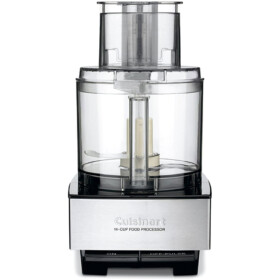
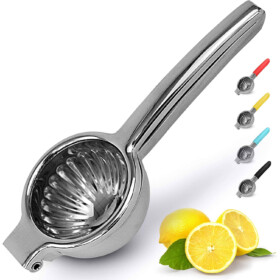

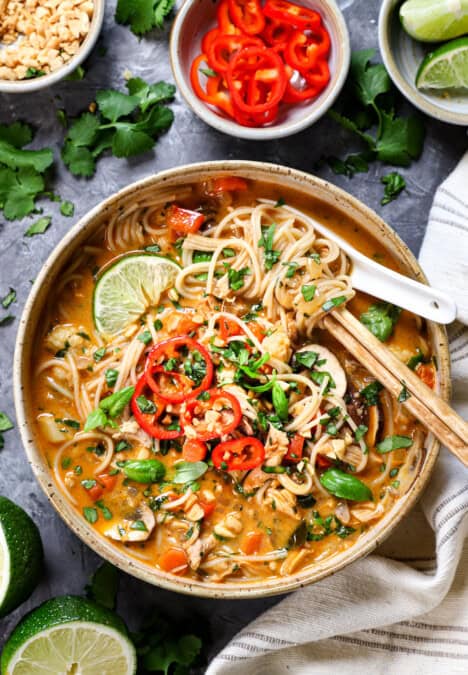
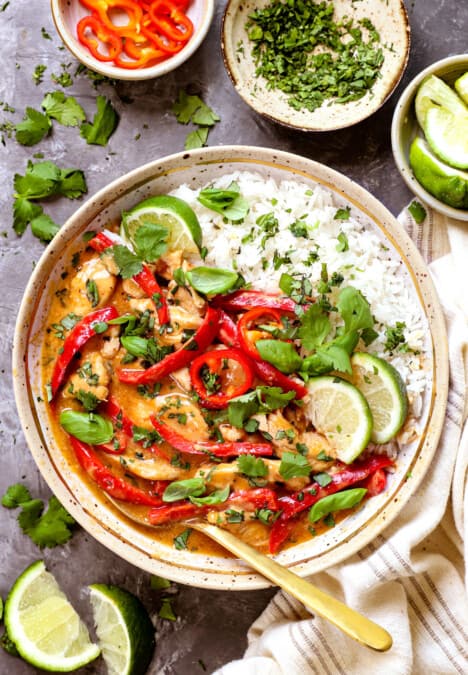
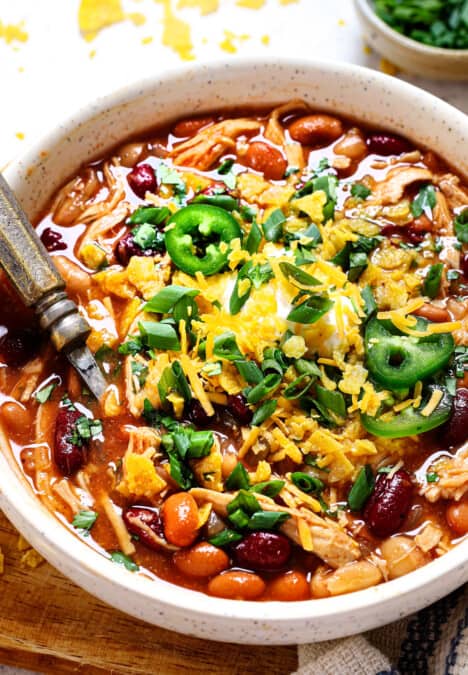
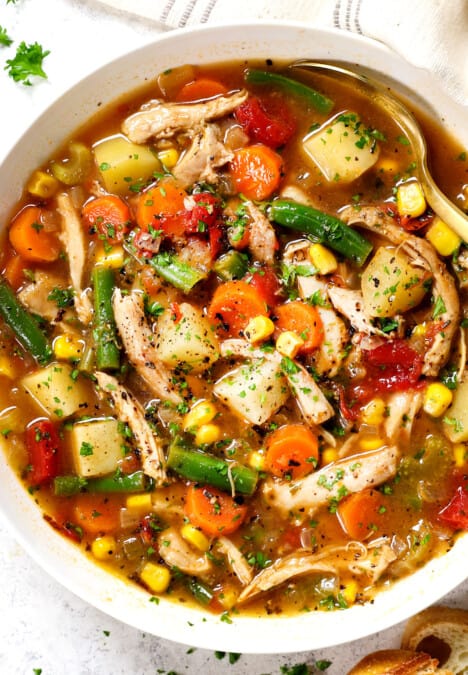
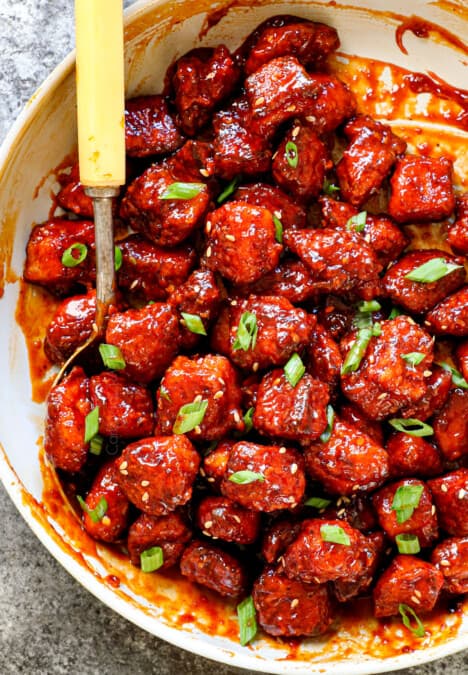
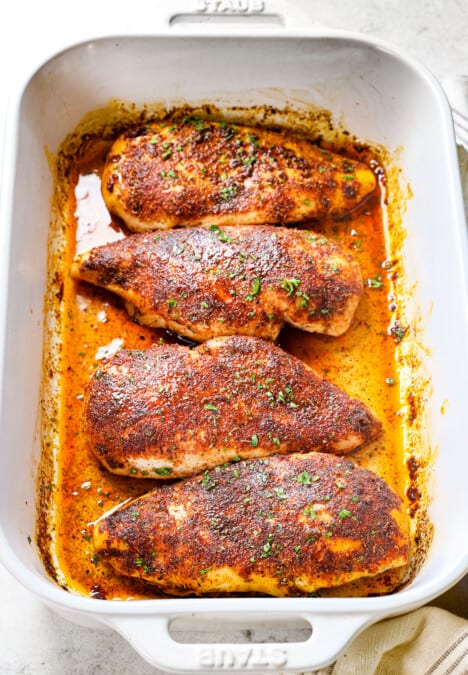























Greg says
Jen….I just LOVE your recipes. I have tried many of them and just can’t get enough.
What I like the VERY MOST of your posting is that you ALWAYS give a History/Origination of your recipes.
Looking forward to many more.
Jen says
Thank you so much for your kind comment Greg! I am honored you’re loving my recipes and my posts! Your comment means an extra lot to me because some readers just wan the recipe 😉 – so thank you!
AnnfromAK says
Amazing recipe! I better order these ingredients soon for delivery!! I might be quarantined but that doesn’t mean I can’t eat well!
Jen says
Agreed! Cooking is the highlight of quarantine! I’m excited for you to try it!
Angela says
I’ve been looking for a homemade mojo recipe for a long time. We’ve always bought the bottled version in the store. Thank you so much for sharing this, I know it’s going to be great!
I love how you explain what each component of the recipe adds to the flavor and subtlety so that we can learn how to become better experimenters in our own kitchen.
Jen says
You’re so welcome Angela, I’m excited for you to replace your bottled version! I’m so happy you find the explanations helpful – it’s so fun to experiment once you have the tools!
Rene says
Jen, as always, I love all of your recipes. This one was no exception. I made it tonight with oranges, lemon and lime from our trees and served it on grilled chicken thighs and summer squash. Yum. Just yum! I did have to make one small change though. My CSO does not eat cilantro so I substituted fresh watercress. Gave it a nice peppery punch. Thanks as always for another great recipe. Bless you!
Jen says
Thank you for making my recipes Rene! That’s awesome you made this mojo already and I love that you were able to use citrus from your own trees! Your watercress swap was brilliant!
Judith Lyon says
help! I slow cooking this Mojo marinade on pork shoulder, but what can I serve it with for company tomorrow.!
Jen says
Hi Judith, you can serve rice or cilantro lime rice https://carlsbadcravings.com/one-pot-cilantro-lime-rice-with-black-beans/ black beans, mango, pineapple or pina colada fruit salad https://carlsbadcravings.com/pina-colada-fruit-salad/ or fruit salad with honey lime vinaigrette https://carlsbadcravings.com/fruit-salad/ grilled corn on the cob or corn salad https://carlsbadcravings.com/corn-salad/ You can also check my “side and lighter fare cravings” in my recipe index. Have fun!
Guillermo says
A better explanation is impossible. Uncompromising cuban flavor. Awesome! It’s just great!. Bless you.
Jen says
Thank you so much Guillermo!
Stephanie says
This past weekend, I wanted to make your new Harissa chicken recipe but the husband saw a mojo chicken recipe on one of his bbq sites, he wanted to try that instead. I went to your website, saw you had a mojo recipe as well so went with your recipe because well, yours are always the best. Gave the chicken a good long marinade, basted with some held back marinade during grilling and served alongside your coconut ginger red beans and rice recipe. Dang girl, that was one delicious family dinner. Thank you!
Jen says
I’m honored my mojo recipe won out and that it was a hit! I love how bright and flavorful that one is. You’re entire meal sounds fantastic! I love how adventurous your family is in the kitchen (or grill)!
Toney Kostelnik says
I quite like looking through a post that can make people think. Also, thank you for permitting me to comment!
Jen says
Thanks Toney, I hope you love it!
JONESCRUSHER says
The food company GOYA sells Sour orange juice( one of the key ingredients in this marinade). You can find it in Walmart’s foreign food aisle.
Jen says
Great tip, thanks so much!